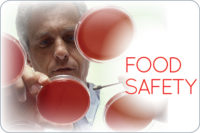That’s why representatives of many U.S. packers and processors joined beef producers, retailers, foodservice operators and government officials to establish “best practices” to meet new guidelines for sampling, lotting and testing beef products — the “Guidance Document for Sampling and Lotting of Beef Products and Sample Analysis for Pathogens.”
The new guidance document is a resource for packers and processors looking for step-by-step procedures for sampling, lotting and analyzing beef and beef products for the presence of pathogens. The best practices will assist beef processing companies in implementing proven pathogen-testing programs as part of a multiple-hurdle food-safety system aimed at advancing beef safety.
The No. 1 goal of the new guidance document is to eliminate pathogens from the beef supply by placing multiple hurdles along the beef production chain. With product testing, we can validate that the multiple hurdles are working to reduce the incidence of potential pathogens in the food supply. Developed through the Beef Industry Food Safety Council (BIFSCo), the guidelines bring together the industry’s best knowledge coupled with years of experience in developing efficient and accurate sampling, lotting and pathogen analysis systems, essential to establishing sound food-safety programs for the beef industry.
The new guidelines plainly explain the proper procedures and methods that should be used to sample, lot and analyze different types of beef products, such as whole-muscle cuts, trimmings destined for ground-beef production, as well as frozen ground beef. While the guidelines are voluntary, they simplify the process for companies that are revising their current sampling programs or creating new ones.
They serve as a roadmap for implementing the most current safety knowledge to optimize safety programs while also identifying the expectations and issues that should be considered when developing a program for pathogen testing.
Engaging the industry in united efforts
These new guidance practices for sampling, lotting and testing beef products were released at the ninth annual Beef Industry Food Safety Summit, hosted by BIFSCo. The event brings together more than 240 top industry leaders who share a commitment to the highest principles and most effective practices with a common goal: offer the safest possible beef supply. The summit is becoming one of the most recognized and respected food-safety organizations in both industry and government. Both the summit and BIFSCo are funded in part by the Beef Checkoff Program.
BIFSCo unites the industry around the common goal of improving beef safety, and nowhere is this unity more evident than at the summit. It gives company food-safety officials a chance to work with their colleagues in similar companies, as well as with their suppliers and customers. The face-to-face relationship-building is a big reason the event receives a large turnout every year.
Because the summit isn’t open to the public or the media, participants can be comfortable in speaking freely. Company officials are honest as they share safety issues in their operations and ways to learn from them. Informative programs on emerging pathogens and important new sampling and testing techniques give attendees new knowledge. Research is presented and companies with beef safety products are on hand to describe their ideas.
Now, more than 70 diverse organizations are members of BIFSCo, representing equipment manufacturers, packers, testing laboratories, grinders, restaurant operators and processors. All members unite through BIFSCo to identify food-safety solutions through research and best-practices documents.
Our commitment to providing the safest beef products possible to our domestic and global beef consumers is unwavering, and this new document is an example of that commitment. The Guidance Document for Sampling and Lotting of Beef Products and Sample Analysis for Pathogens and additional best-practices documents are available, free of charge, in the technical resource section of www.bifsco.org.
These documents were developed by groups of industry representatives who have applied their collective knowledge and summarized the current science and technology information that can be applied to beef safety systems. The documents are dynamic and are updated as the science evolves and new data is collected.
I encourage you to also visit www.bifsco.org for details about the 2012 Beef Industry Safety Summit in Tampa, Fla. and how to become a member of BIFSCo.





Report Abusive Comment